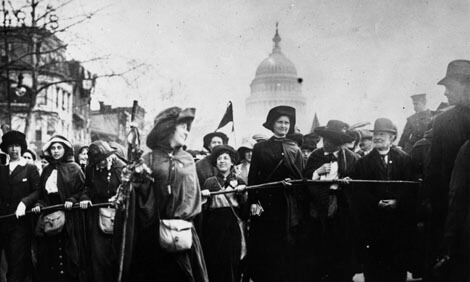


Suffragist Rosalie Jones led a group of protesters down Pennsylvania Avenue in Washington, D.C., as part of the suffrage parade of 1913.
August was recently named National Women’s Suffrage Month to celebrate the 100th anniversary of the ratification, or formal approval, of the Nineteenth Amendment. People all around the country are celebrating the women who worked to expand women’s rights by sharing history, creating art, or encouraging people to vote. Many are also attending virtual events and touring online exhibits.
Women rights activists, often called suffragists, had been working for equal rights since the mid-1800s. By 1915, women in many states were allowed to vote in at least some state and local elections. Yet, more than 20 states still did not allow women to vote for President. Meanwhile, 15 states had granted women full voting rights by this time, but most of those states were in the West. In 1918, a constitutional amendment to give women full voting rights throughout the nation was proposed in the House of Representatives. The Nineteenth Amendment was passed by the U.S. Congress on June 4, 1919 and ratified on August 18, 1920. This amendment gave women suffrage, or the right to vote, in all elections.
Still, the Nineteenth Amendment did not guarantee voting rights for all women. There were laws that discriminated against Black people and worked to block them from voting. It took another 45 years for the passage of the Voting Rights Act of 1965 to ban these laws, so that Black women finally had full voting rights. There are still practices today that make it more difficult for some groups of people to vote.
A number of museums and historic sites related to women’s suffrage are temporarily closed due to the coronavirus pandemic. Yet, people are still able to celebrate this important event in many ways. In Seneca Falls, New York, visitors can still tour the outdoor areas of the Women’s Rights National Historical Park. The first women’s rights convention was held in Seneca Falls in 1848.
In Washington, D.C., people can walk the route of the first suffrage parade held in the nation’s capital, which took place in 1913. The suffragists marched down Pennsylvania Avenue, passing important government buildings such as the Capitol and the White House. Journalist and voting rights activist Ida B. Wells was told to march in the back of the parade because she was Black, but she refused. She said, “Either I go with you or not at all.” Wells was supported by her White fellow suffragists Belle Squires and Virginia Brooks.
In some places across the country, women held demonstrations about the power of the vote. In Orlando, Florida, the League of Women Voters of Orange County hosted an event to take place at the same time as their state’s primary elections. They led a socially distanced demonstration, carrying signs and dressed as suffragists from 100 years ago. They wore sashes that said, “Votes for All,” and encouraged everyone to participate in the primary elections.
On August 18, a performance of a new play was available to watch online. The play is adapted from the book Finish the Fight!: The Brave and Revolutionary Women Who Fought for the Right to Vote. The book and play tell the stories of women from several minority groups—Black, Asian American, Hispanic American, Native American, and LGBTQ—who were important, lesser-known activists of the women’s suffrage movement.
The Nineteenth Amendment was officially adopted, or put into practice, on August 26, 1920. Women’s Equality Day is now celebrated every year on that date. To memorialize the occasion this year, landmarks across the country will be lit in purple and gold, the official suffrage colors. The project responsible for these illuminations is called Forward Into Light in honor of the suffrage slogan “Forward through Darkness, Forward Into Light.” Some of the landmarks that will be lit up include the Statue of Liberty in New York City and the Golden Gate Bridge in San Francisco.
Today, women are still working toward equality in government and in the workplace. Many women’s rights activists agree that voting in this year’s elections is the best way to celebrate the passage of the Nineteenth Amendment.
Image credit: ©Topical Press Agency/Hulton Archive/Getty Images
Related Links
- Finish the Fight!: The Brave and Revolutionary Women Who Fought for the Right to Vote
Find out about a new book that shares the stories of women from diverse backgrounds who helped lead the fight for suffrage. Also check out the printable voting game and “Finish the Fight” trading cards. - Celebrating a Century of Women’s Suffrage with Finish the Fight!
Download a sample of the book Finish the Fight! and try out some activities to celebrate 100 years of women’s suffrage. - The Magic Sash
Listen to this historical fiction podcast in which Lotty and Isaiah, two fifth graders, travel back in time and meet heroes of the women’s suffrage movement. - Shall Not Be Denied: Women Fight For the Vote
Visit an online Library of Congress exhibit about the ongoing movement for women’s voting rights.



























